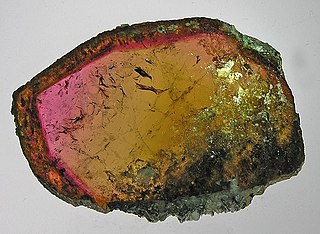
Tourmaline is a crystalline silicate mineral group in which boron is compounded with elements such as aluminium, iron, magnesium, sodium, lithium, or potassium. This gemstone comes in a wide variety of colors.

Bornite, also known as peacock ore, is a sulfide mineral with chemical composition Cu5FeS4 that crystallizes in the orthorhombic system (pseudo-cubic).

Clinoclase is a hydrous copper arsenate mineral, Cu3AsO4(OH)3. Clinoclase is a rare secondary copper mineral and forms acicular crystals in the fractured weathered zone above copper sulfide deposits. It occurs in vitreous, translucent dark blue to dark greenish blue colored crystals and botryoidal masses. The crystal system is monoclinic 2/m. It has a hardness of 2.5–3 and a relative density of 4.3. Associated minerals include malachite, olivenite, quartz, limonite, adamite, azurite, and brochantite among others.

Epidote is a calcium aluminium iron sorosilicate mineral.
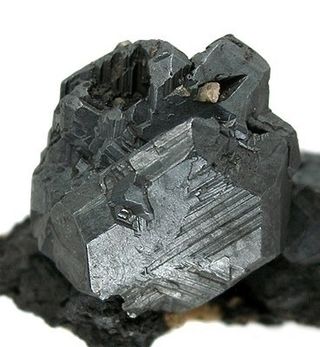
Chalcocite, copper(I) sulfide (Cu2S), is an important copper ore mineral. It is opaque and dark gray to black, with a metallic luster. It has a hardness of 2.5–3 on the Mohs scale. It is a sulfide with a monoclinic crystal system.

Aurichalcite is a carbonate mineral, usually found as a secondary mineral in copper and zinc deposits. Its chemical formula is (Zn,Cu)5(CO3)2(OH)6. The zinc to copper ratio is about 5:4. Copper (Cu2+) gives aurichalcite its green-blue colors.

Adamite is a zinc arsenate hydroxide mineral, Zn2AsO4OH. It is a mineral that typically occurs in the oxidized or weathered zone above zinc ore occurrences. Pure adamite is colorless, but usually it possess yellow color due to Fe compounds admixture. Tints of green also occur and are connected with copper substitutions in the mineral structure. Olivenite is a copper arsenate that is isostructural with adamite and there is considerable substitution between zinc and copper resulting in an intermediate called cuproadamite. Zincolivenite is a recently discovered mineral being an intermediate mineral with formula CuZn(AsO4)(OH). Manganese, cobalt, and nickel also substitute in the structure. An analogous zinc phosphate, tarbuttite, is known.

Datolite is a calcium boron hydroxide nesosilicate, CaBSiO4(OH). It was first observed by Jens Esmark in 1806, and named by him from δατεῖσθαι, "to divide," and λίθος, "stone," in allusion to the granular structure of the massive mineral.

Clausthalite is a lead selenide mineral, PbSe. It forms a solid solution series with galena PbS.

Digenite is a copper sulfide mineral with formula: Cu9S5. Digenite is a black to dark blue opaque mineral that crystallizes with a trigonal - hexagonal scalenohedral structure. In habit it is usually massive, but does often show pseudo-cubic forms. It has poor to indistinct cleavage and a brittle fracture. It has a Mohs hardness of 2.5 to 3 and a specific gravity of 5.6. It is found in copper sulfide deposits of both primary and supergene occurrences. It is typically associated with and often intergrown with chalcocite, covellite, djurleite, bornite, chalcopyrite and pyrite. The type locality is Sangerhausen, Thuringia, Germany, in copper slate deposits.
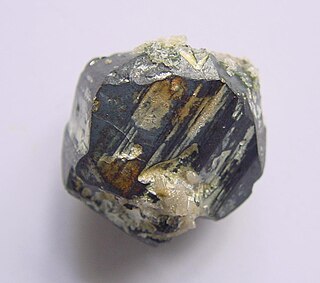
Djurleite is a copper sulfide mineral of secondary origin with formula Cu31S16 that crystallizes with monoclinic-prismatic symmetry. It is typically massive in form, but does at times develop thin tabular to prismatic crystals. It occurs with other supergene minerals such as chalcocite, covellite and digenite in the enriched zone of copper orebodies. It is a member of the chalcocite group, and very similar to chalcocite, Cu2S, in its composition and properties, but the two minerals can be distinguished from each other by x-ray powder diffraction. Intergrowths and transformations between djurleite, digenite and chalcocite are common. Many of the reported associations of digenite and djurleite, however, identified by powder diffraction, could be anilite and djurleite, as anilite transforms to digenite during grinding.
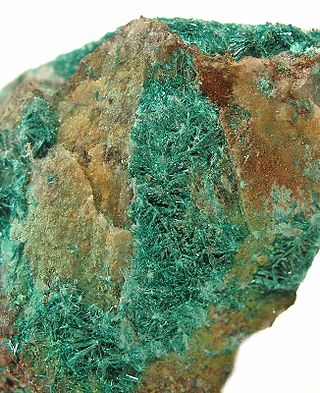
Botallackite, chemical formula Cu2(OH)3Cl is a secondary copper mineral, named for its type locality at the Botallack Mine, St Just in Penwith, Cornwall. It is polymorphous with atacamite, paratacamite and clinoatacamite.
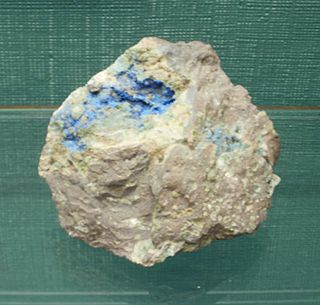
Calumetite is a natural rarely occurring mineral. It was discovered in 1963 at the Centennial Mine near Calumet, Michigan, United States. Calumetite was first discovered along with anthonyite. It has a chemical formula of Cu(OH,Cl)
2•2(H
2O).

Plancheite is a hydrated copper silicate mineral with the formula Cu8Si8O22(OH)4•(H2O). It is closely related to shattuckite in structure and appearance, and the two minerals are often confused.

Tyrrellite is a selenide mineral that has a chemical formula of Cu(Co,Ni)2Se4. It has been found in the Goldfields District in northern Saskatchewan, as well as in the Petrovice deposit, Czech Republic. It is named after the Canadian geologist Joseph Burr Tyrrell. Joseph Tyrrell was one of the first geologists from the Geological Survey of Canada to do research in the Goldfields District.

Geerite is a copper sulfide mineral with the chemical formula Cu8S5. The mineral is named after the original collector, Adam Geer, of Utica, New York, US.

Piypite is a rare potassium, copper sulfate mineral with formula: K2Cu2O(SO4)2. It crystallizes in the tetragonal system and occurs as needlelike crystals and masses. Individual crystals are square in cross-section and often hollow. It is emerald green to black in color with a vitreous to greasy luster.
Copper selenide is an inorganic binary compound between copper and selenium. The chemical formula depends on the ratio between the two elements, such as CuSe or Cu2Se.

Kruťaite, simplified Krut'aite or krutaite, is a rare mineral with the formula CuSe2. It crystallises in the cubic crystal system. It is part of the pyrite group, being composed of Cu2+ ions and Se22− ions. The mineral is most often found as a dark grey aggregate consisting of tiny crystals no more than a millimeter in size. The crystals are opaque in any size. It has no industrial use, but it is a prized collector's item.

Berzelianite is a rare copper selenide mineral with the formula Cu2Se. It occurs as thin dendritic crusts or as fine-grained inclusions. It crystallizes in the isometric system, unlike its dimorph, bellidoite, which crystallizes in the tetragonal system. The crystals are opaque and slightly malleable.



















